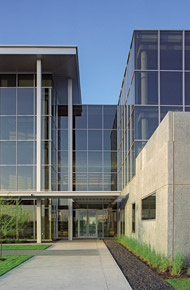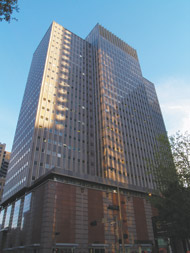| FEATURE ARTICLE, OCTOBER 2009
LEED MARCHES AHEAD
The update to LEED 3.0 has brought changes to its professional accreditation.
By Coleman Wood
Much coverage has been given in the past few years to the U.S. Green Building Council’s (USGBC) Leadership in Energy Efficiency & Design (LEED) program, which certifies construction projects for sustainability. However, LEED has another facet that does not receive as much attention: its professional certification program.
The LEED - Accredited Professional (AP) credential was first developed in 2001 as a way to recognize professionals with specialized knowledge in the field of sustainable building. The original goal was to use the credential to educate people in the fundamentals of green building and design while providing a professional designation for those who have obtained this specialized knowledge. To gain the designation, a rigorous test must be taken to demonstrate intimate knowledge of green building techniques.
“[LEED-AP certification] says to the world that the holder is on the forefront of the industry, and that rings true with the commercial real estate industry,” says Ashley Katz, communications manager with the U.S. Green Building Council.
When LEED version 3.0 was unveiled earlier this year, the AP credential underwent a similar transformation. Formerly, there was only one credential that all professionals could earn. One of the changes was the addition of a tiered credential system in which professionals first take the test for the Green Associate (GA) credential, then advance to the AP designation.
 |
The 11000 Equity Drive Building is a 60,000-square-foot property in Houston. Designed by Kirksey, the project received LEED-Core & Shell Gold rating.
|
|
“I think it’s a good step that the USGBC has created the Green Associate [credential], because there are a lot of folks that are going to take advantage of it and not necessarily have to go into the depth of a particular [specialty],” says Brian Malarkey, director of the architecture firm Kirksey’s EcoServices sustainable design division.
The GA credential is ideal for people involved in sustainability but not necessarily in the building aspect. People such as real estate brokers, consultants and sustainable product manufacturers could show that they have green knowledge without having to study for the much more detailed AP exam. The GA credential also serves as a good first step for those who later wish to take the AP test by familiarizing them with the general information relating to the sustainability industry.
The AP credential also underwent a change. Previously, there was just a general designation that professionals could obtain. LEED 3.0 divided the AP credential into four specialties: Building Design + Construction, Interior Design + Construction, Operations + Maintenance and Homes. The future will see even more changes to LEED-AP; a neighborhood development specialty will be added, and the top tier of the LEED professional accreditation, LEED Fellow, will be offered to those with a set number of years of sustainable building experience.
“[The] specialization aspect…opens up the LEED credential to people who wouldn’t necessarily be motivated to do it previously, because now there is a specialty for interior design, which opens it up to designers, and neighborhood development, which opens it up to development companies who would not have been interested previously,” says Effie Brinson, a co-vice chair with the Central Texas – Balcones chapter of the USGBC.
Right before the transition to LEED 3.0 took place, a rush was seen in people taking the test to get accredited under the LEED 2.2 guidelines. Because of this, there are now 131,655 LEED-APs as of July 2009. “The fact that there are more than 100,000 LEED-APs out there in the building and construction industry really says that this is something worth paying attention to,” Katz says.
With the increasing popularity of the LEED-AP designation, another industry is emerging as people look for courses to prepare them for the difficult test. Another part of Kirksey’s green building platform is free courses the company offers to prepare people for the test. The course consists of four 2-hour classes that offer a general introduction into the LEED program, then goes into detail about the different credits in the green building certification program.
“The reason that we started these courses is that we were interested in getting all of the consultants we work with and our clients up to speed,” Malarkey says. “We want everyone to know as much as they can about LEED and green building because we are working with them every day.”
According to Malarkey, Kirksey has graduated approximately 1,000 people in the 3 years it has been offering the classes. The course is not affiliated with the USGBC—Malarkey prefers to call it a “study group”—but it is approved by several real estate organizations.
Other classes are expected to pop up with the development of the new Credential Maintenance Program for LEED-AP designees. To maintain the credential, professionals are expected to complete 30 hours of continuing education every 2 years. While the system is still being finalized, activities such as conferences, workshops and working on green projects would count toward a professional’s education. It is here that Malarkey sees even more opportunity for economic growth.
“I think you are going to see a similar shift as when the AIA [America Institute of Architects] required continuing education credits, where there is a whole industry that opens up that centers itself around [offering courses],” Malarkey says.
Still, there are professionals that are skeptical about LEED-AP certification. All of those in the sustainable sector are quick to point out that misconceptions abound when it comes to the LEED program. Part of the goal of the USGBC is to set the record straight.
“In a nutshell, it’s the difference between perception and reality,” says Jane Baxter Lynn, executive director with the Central Texas – Balcones USGBC chapter. “My argument [is] there is a perception out there that LEED is difficult, it’s complicated and it’s expensive. By taking LEED education and training, they would understand that most of those perceptions are not true.”
As the LEED program enters its third incarnation, it is clear that it is not a design fad that will go away in time. In fact, it seems to be becoming the norm. Some companies are already requiring their employees to have the LEED-AP credential and some organizations, particularly government and higher education entities, are requiring all of their projects to be LEED-certified.
“When the USGBC started out, their mission was to transform the marketplace — the accreditation program being one of the pieces...If you think about it, that’s what they did in the most amazing, effective way by getting everyone involved,” Malarkey says.”
Houston High-Rise Earns LEED EB: O&M Certification
 |
919 Milam office tower in downtown Houston
|
|
The historic 919 Milam office tower in downtown Houston has earned LEED for Existing Buildings (EB): Operations & Maintenance (O&M) Silver certification. The 24-story, 543,000-square-foot property, which was built in 1956, is owned by Transwestern Investment Company (TIC), a private equity real estate investment firm. Transwestern (TW) handles management and leasing.
Numerous green design and operational features were implemented at 919 Milam to earn the Silver certification, including the installation of new restroom fixtures and CO2 sensors. Additionally, TIC started green cleaning and building recycling programs at the property and made improvements to reduce energy consumption and improve water efficiency.
TW currently is seeking LEED EB: O&M certification with nearly 100 buildings in its Transwestern-managed portfolio.
— Lindsey W. Marcec |
©2009 France Publications, Inc. Duplication
or reproduction of this article not permitted without authorization
from France Publications, Inc. For information on reprints of
this article contact Barbara
Sherer at (630) 554-6054.
|
